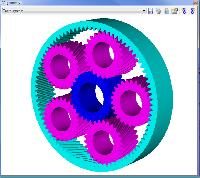KISSsoft Update Integrates Parasolid CAD Core

The machine element package by KISSsoft for the design and optimization of components like gears, shafts, bearings and others is now available in the new version 04/2010. "There are currently two strong trends for the computer based calculation of machine elements like gears, shafts, bearings and so on: one is the combination of Finite Elements with the standardized methods, the other is the tighter combination of the software tools in the machine design process by interfacing or even combining software for different tasks in this process," says Dr. Stefan Beermann, vice president at KISSsoft. "In the current version of KISSsoft there is a CAD core (Parasolid) and a Finite Element library included, to take this fact into account. The standards defining calculation methods still remain their importance, but seem to be no longer sufficient for a competitive product design: the methods must be extended for practical application."
Improvements to the software package include the integration of the parasolid CAD core into the software, so exact 3-D models are directly available for most gear types. Users can also utilize the generated model for load distribution analysis and stress and deformation analysis using FEA. The model can also be used for any kind of post-work such as local modification of the tooth surface for optimal load distribution and transmission error. Due to the STEP interface and the native parasolid format, these models can be exported to other software packages. For the most common 3-D CAD packages in machine design, however, the direct integration of KISSsoft into these packages provides fully parameterized models, according to the company's press release.
A second section with major improvements is the tooth contact analysis for cylindrical gears. The stiffness model was extended to better take the load distribution in the width direction into account. For this purpose, the gear is split up into a number of slices. Each slice has a contact stiffness function assigned that is dependent on the meshing position, according to the model of Peterson. The single slices are then connected by springs with a stiffness value derived from the contact stiffness of the neighboring slices. Based on this model, the real contact between the flanks is determined, considering deformation of the teeth, modifications, misalignment and manufacturing errors. As a consequence, the user gets graphs and numerical results for forces, stresses, transmission error, power loss and temperature-and for dry running plastic gears even the wear on the flanks. The KISSsoft material database now incorporates material properties of 17 additional LNP specialty compounds from the SABIC Innovative Plastics portfolio for gear design. This data is now available for KISSsoft and includes temperature-dependent values for Young's modulus, static bending strength as well as characteristic wear values at dry-run.
In the draft of the planned ISO/CD TR 6336-7, for the calculation of the lubrication gap and the analysis of the risk of micropitting, the calculation of the permissible lubricant film thickness lGFP was not covered. In the meantime, it was decided that the calculation will not be a part of the 6336-standard, but it will become the Technical Report ISO/TR 15144. According to the latest proposal for the Committee Draft, the ISO/CD TR 15144, the permissible lubricant film thickness is included. So, a reliable evaluation method of the safety against micropitting could be implemented in KISSsoft. With the AGMA 925, not only the determination of the permissible lubricant film thickness is possible, but also the probability of scuffing and wear can be calculated. Furthermore, the latest method for scuffing calculation, the ISO/TR 13989, is now available.
There are two more standards for cylindrical gears newly implemented: The AGMA 6011 for open gears and AGMA 6014 for speed increasers. For the configuration of steel worm with plastic gear, the guideline VDI 2736, the successor of the old VDI 2545 plastic gear guideline, contains a method calculating the worm gears root strength based on the shear stress in the root. The new KISSsoft version implements the current state of this method. It should be noted, however, that this standard is still under development, and significant changes might still occur.
Another highlight of KISSsoft 04/2010 is the possibility to determine the transmission error directly in the fine sizing. This allows the comparison of the different variants according to noise rating. Several standards were added regarding bevel gear calculation. The Klingelnberg standards have been implemented for spiral and hypoid gears with palloid method. Furthermore, the draft for ISO/TR 10300, with the calculation of hypoid gears, is implemented too. Parallel to the standards, a KISSsys functionality was developed in order to calculate the relative position of pinion and ring gear under load, considering the deflections of bearing and shafts.
There are several more improvements in the software like the addition of splines according to DIN 5481 and DIN 5482, the extension of the calculation of interference fits to the plastic range, implementation of strength classes for bolts according to SAE J429, for bolts, nuts and washers according to ASME 18.2.1-1996, 18.2.2-1987 and B18.22.1-1965 (R1998), the calculation of the relaxation of garter springs, and the generation of 3-D shaft models in several CAD packages.
In KISSsys, the GPK Model used for sizing of one- to five-stage gearboxes is enlarged by some significant improvements. The main functionality is the automatic transfer of the relative position of gears, considering the shaft and bearing deflections. Together with the previously mentioned tooth contact analyses, the user is able to optimize and analyze the gear modifications under real conditions. Other functionalities are the import of housings and the collision check with the gear elements. In the field of the precision mechanics, the automatic shaft and bearing sizing is optimized, and proposals for smallest designs are calculated. The free test version of the new release 04/2010 is available for download at www.KISSsoft.com.





